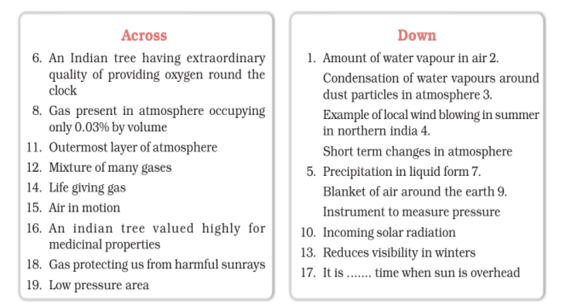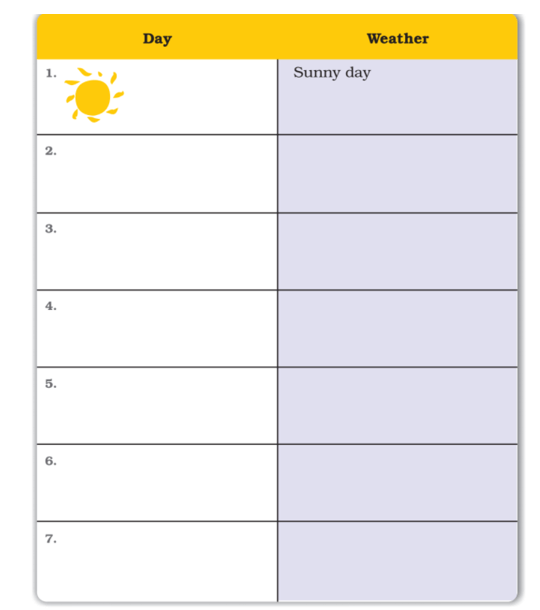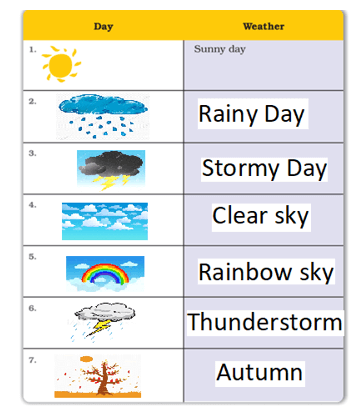Geography - Class 7
Our Environment
Chapter 4: Air
Question 1:Answer the following questions.
(i) What is atmosphere?
Answer:Our Earth is surrounded by a huge blanket of air called the atmosphere. It provides us the air that we breathe and protects us from the harmful effect of the sun's rays.
(ii) Which two gases make the bulk of the atmosphere?
Answer:Nitrogen and oxygen are the two gases that make the bulk of the atmosphere.
(iii) Which gas creates the greenhouse effect in the atmosphere?
Answer:carbon dioxide creates the greenhouse effect in the atmosphere.
(iv) What is the weather?
Weather is the hour to hour and day-to-day condition of the atmosphere. It can change dramatically from day to day.
(v) Name three types of rainfall?
Answer:The three types of rainfalls are:
- Convectional rainfall
- Orographic rainfall
- Cyclonic rainfall.
(vi) What is air pressure?
Answer:Air pressure is defined as the pressure exerted by the weight of air on the earth’s surface. The air always moves from high-pressure areas to low-pressure areas.
Question 2:Tick the correct answer.
(i) Which of the following gases protects us from harmful sun rays?
(a) Carbon dioxide
(b) Nitrogen
(c) Ozone
(ii) The most important layer of the atmosphere is
(a) Troposphere
(b) Thermosphere
(c) Mesosphere
(iii) Which of the following layers of the atmosphere is free from clouds?
(a) Troposphere
(b) Stratosphere
(c) Mesosphere
(iv) As we go up the layers of the atmosphere, the pressure
(a) Increases
(b) Decreases
(c) Remains the same
(v) When precipitation comes down to the earth in the liquid form,it is called
(a) Cloud
(b) Rain
(c) Snow
Answer:
(i). (c) Ozone
(ii). (a) Troposphere
(iii). (b) Stratosphere
(iv). (b) Decreases
(v). (b) Rain
Question 3:Match the following.
| (i) Trade Winds | (a) Incoming solar energy |
| (ii) Loo | (b) Seasonal wind |
| (iii) Monsoon | (c) Horizontal movement of Air |
| (iv) Wind | (d) Layer of ozone gas |
| (e) Permanent wind | |
| (f) Local wind |
Answer:
| (i) Trade Winds | (e) Permanent wind |
| (ii) Loo | (f) Local wind |
| (iii) Monsoon | (b) Seasonal wind |
| (iv) Wind | (c) Horizontal movement of Air |
Question 4:Give reasons.
(i) Wet clothes take longer time to dry on a humid day?
Answer:The air is full of water vapour on a humid day. When the air gets warmer, its capacity to hold the water vapour increases and so it becomes more and more humid. Thus, On a humid day, clothes take longer to dry, and sweat from our body does not evaporate easily, making us feel very uncomfortable.
(ii) Amount of insolation decreases from equator towards poles?
Answer:Insolation is referred to as the amount of solar energy that is received by the earth. The sun's rays fall vertically on the equator. And it falls at some angle on the poles. That's why the amount of insolation decreases from the equator towards the poles.
Question 5:For Fun.
Solve the crossword puzzle with the help of given clues:


Answer:
- Humidity
- Cloud
- Loo
- Weather
- Rain
- Peepal
- Atmosphere
- Carbon dioxide
- Barometer
- Insolation
- Exosphere
- Air
- Fog
- Oxygen
- Wind
- Neem
- Noon
- Ozone
- Cyclone
(ii) Make a weather calendar for one week. Use pictures or symbols to show different types of weather. You can use more than one symbol in a day, if the weather changes. For example, the sun comes out when rain stops. An example is given below:

Answer:

Intext Questions:
Question :Is global warming a serious issue in today’s world?
Answer:Yes, global warming is a serious issue because:
- Ice is melting worldwide, especially at the Earth’s poles. Much of this melting ice contributes to sea-level rise.
- Rising temperatures are affecting wildlife and their habitats.
- As temperatures change, many species are on the move.
- Precipitation (rain and snowfall) has increased across the globe.
- some regions are experiencing more severe drought, increasing the risk of wildfires, lost crops, and drinking water shortages.
- Some species—including mosquitoes, ticks, jellyfish, and crop pests—are thriving.